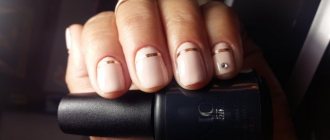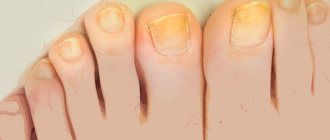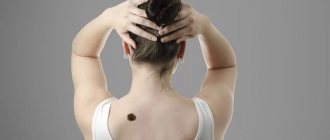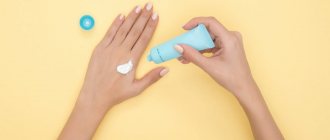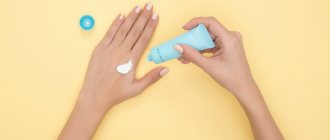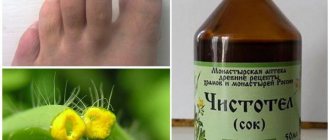White spots of nails (Betekhtin M.S.)
White spots on the nails are quite common and are usually not dangerous. Many people have had such spots at least once in their lives.
The medical name for this phenomenon is leukonychia, and its manifestation on the nails most often does not turn out to be a consequence of a serious illness.
White spots can vary in appearance: thin dots, wide lines, lines crossing the nail, or individual wide spots.
Causes of white spots on nails
1) Allergic reaction
Allergic reaction to components of nail polish, gloss, hardener or remover.
2) Nail fungus (onychomycosis)
When white superficial onychomycosis appears, the first sign of infection may be small white dots on the nail. Typically, the infection gradually involves the entire nail and spreads to the nail bed. Additionally, toenails may become layered and then thick and brittle.
3) Damage to the nail
The most common cause of white spots is damage to the nail bed, which can occur when the nail or finger is pricked, hit, or pinched. Frequent manicures, pedicures, and the use of gels or acrylic nails can also damage the nail bed. Damage to the base of the nail can cause whiteheads and spots to appear as the nail grows. But, since the growth time of the nail is long, it can be difficult to independently associate the damage with subsequent manifestations. Some damage may not appear until after 4 weeks.
4) Lack of minerals
A lack of minerals such as zinc and calcium in the body can cause white spots to appear.
5) Other reasons
The most rare causes of white spots on nails: heart disease, poor health, liver or kidney failure, psoriasis or eczema, pneumonia, arsenic poisoning.
Diagnostics
If white spots appear infrequently and the most likely cause is injury, then there is no need to visit a doctor.
If stains are constantly present on the nails or they become more numerous, then you should consult a specialist. Most of the causes of white spots can be easily eliminated with proper diagnosis.
At your appointment, the doctor will examine your nails, as well as your hands or feet. Based on the examination, a diagnosis will be assumed and, if necessary, additional tests and treatment will be prescribed.
Treatment
Treatment directly depends on the cause of white spots. In case of an allergic reaction, stop using varnishes, gels, etc. In case of fungus, use appropriate antifungal agents. Nail injury requires time to heal and preventive measures.
Author of the publication: Betekhtin Mikhail Sergeevich, dermatovenerologist, candidate of medical sciences.
White spots on nails: causes and prevention
Today we will look at such a common problem as the appearance of white spots on the nails. The material was prepared by the technologist of our line for manicure and pedicure DoctorDerm Evgenia Fesenko.
Let's look at a case in which we know for sure that the nails are healthy, there is no fungus, onycholysis and other problems.
The client walked around with normal nails, the master painted his nails according to all the rules (varnish, vinyl lux or gel polish) and suddenly spots appeared.
Why did this happen?
The nail plate consists of compressed keratin cells; these cells hold together particles of moisture and fat. This results in a layered structure. When wet, it expands slightly in thickness and becomes more elastic; when dry, it narrows and becomes more fragile.
Artificial turf
– this is a film of a certain thickness and elasticity; it does not change its properties when wet and dry. Varnish, vinyl lux - thin hard glass, gel varnishes, depending on the manufacturer's brand, have different thicknesses and elasticity.
Now imagine a nail covered with varnish. The nail is alive and elastic, depending on its moisture content. Two surfaces adhere firmly to each other - artificial (varnish, gel polish) and natural (natural nail).
Under mechanical influence
(working on the keyboard, washing dishes, walking, running, squeezing in shoes) two surfaces begin to move relative to each other. And micro-tears occur between these surfaces. Since the nail plate is less durable due to its layering than any artificial coating, micro-delamination occurs on it. This mainly happens in the stress line area of the nail, i.e. polish or gel polish tears off small particles of the top layer of the nail and pulls the top layer towards itself.
The photo shows an example of white spots on the nails.
In the photo, number 2 indicates the stress zone of the nail.
How to prevent the white spot effect or how to reduce it?
Be sure to warn the client that the wearing period of the coating is limited! Even if the coating adheres perfectly, it must be promptly and professionally removed and replaced.
The nail plate grows, the center of gravity of the coating shifts, pressure and mechanical stress increase.
For varnish or vinyl lux
Wear time on hands is no more than one week, on feet no more than two weeks.
For gel polish, bio-gel or shellac
- on the arms no more than two weeks, on the legs no more than three weeks.
This is an approximate guarantee period that the coating will not cause mechanical damage to the nail plate.
Onychomycosis (nail fungus) - symptoms and treatment
There are several types of treatment for onychomycosis:
- Local therapy.
- Systemic therapy.
- Combination therapy.
- Corrective therapy [2].
Local therapy involves applying medications to the nail plate and nail folds. Indications for local therapy:
- Limited form of damage to the nail plate (according to KIOTOS [4]).
- There are contraindications for prescribing systemic drugs: hypersensitivity, liver disease, renal dysfunction, pregnancy, lactation.
The advantages of this therapy are that high concentrations of the therapeutic agent are formed on the surface of the nail, which does not penetrate into the bloodstream. There are no side effects of using antifungal drugs - nausea, loss of appetite, abdominal pain. The disadvantage of the method is that the medicinal substance does not always reach the pathogen's habitat, especially if the fungi are located in the nail bed or matrix. This in turn can lead to treatment failure. This type of treatment is very labor-intensive, since before applying the drug it is necessary to remove the affected part of the nail [2].
Methods for removing affected nails:
- Mechanical removal using files, nippers or a drill.
- Using keratolytic patches. Before applying a keratolytic plaster, the skin around the nail is sealed with a plaster, a plaster mass (urea with salicylic acid) is applied on top and sealed with an adhesive plaster. The plaster mass is changed every 2-3 days. After each removal, the affected part of the nail is removed mechanically.
- Surgical. This operation is very painful and traumatic, since when the nail plate is removed, the growth zone can be damaged, which leads to the regrowth of deformed nails.
Local antifungal agents are used after removing the affected nail plate. Antimycotics are distinguished according to the place of application:
- applied to the nail: varnishes;
- applied to rollers: creams, ointments, solutions.
The most studied drug for topical use is a 1% solution of naftifine , which has an evidence base for effectiveness in treatment based on a Cochrane meta-analysis [8]. This product is water-based, which facilitates better penetration of the antifungal substance into the affected area. Varnishes, the active ingredients of which are ciclopirox and amorolfine, have a dehydrated base, which reduces the penetration of the drug into the deep layers. Therefore, dermatologists consider the use of varnishes unsatisfactory and increasingly prefer water-based products [10].
To get results from local therapy, it is necessary to follow the treatment regimen; it is important for the patient to be responsible, consistent and patient. The duration of therapy can be up to 12 months.
Systemic therapy allows the antifungal drug to penetrate the bloodstream to the site of the lesion, even if the nail bed and matrix are affected [2]. A high concentration of the drug remains in the affected area for a long time after the end of use. The disadvantages of this type of treatment are associated with the risk of side and toxic effects.
Indications for systemic therapy:
- Common forms of nail plate damage.
- Lack of effect from local therapy (that is, after six months of treatment for onychomycosis on the hands and 9-12 months of treatment for onychomycosis of the feet, healthy nails did not grow back).
To determine treatment tactics, KIOTOS (Clinical Index for Assessing the Severity of Onychomycosis by Sergeev), proposed by A. Yu. Sergeev in 1999, is used. It is used as a therapeutic standard in various countries around the world [3][4].
Medicines for the treatment of onychomycosis can be classified as follows:
- antimycotics - have an antifungal effect;
- antiseptics - have both antifungal and antibacterial effects. They are rarely used, only if there are no other antifungal agents;
- multicomponent - in addition to the antifungal agent, they also contain other drugs, such as anti-inflammatory drugs.
Prescription regimens:
- standard - taking medications daily during the prescribed treatment period;
- shortened - the treatment period is shortened, can be carried out in regular doses or increased;
- intermittent - treatment is prescribed in several short courses, the intervals between courses are equal to the duration of the courses;
- pulse therapy - treatment is prescribed in several short courses, the intervals between courses are longer than the duration of the courses [3].
Antifungal drugs are divided according to the active substance:
- triazoles: itraconazole, fluconazole;
- allylamines: terbinafine, naftifine;
- others: ciclopirox, morpholines [3].
Currently, only third-generation drugs : terbinafine, itraconazole, fluconazole.
Terbinafine acts only on dermatophytes, is highly effective and safe. This drug must be taken every day for a long period of time [2][3].
Itraconazole - covers all types of pathogens of onychomycosis. It accumulates best in the nail. Used in short courses. Highly effective and has a low risk of side effects [2][3]
Fluconazole - acts on dermatophytes and yeast fungi. It is used in long-term courses. Efficiency is average, poorly studied. Prescribed as a second-line drug or in combination therapy.
With combination therapy, local and systemic treatment are carried out simultaneously. Combination therapy is used when it is necessary to increase the effectiveness of systemic therapy and reduce treatment time.
Corrective therapy (treatment of concomitant diseases): to select a treatment regimen, it is necessary to assess the general somatic condition of the body. Diseases such as circulatory disorders in the extremities may reduce the access of the antifungal agent to the lesion. Therefore, drugs are prescribed that improve tissue trophism.
Due to the toxic effect of systemic antifungal drugs, it is necessary to exclude liver diseases and, if necessary, prescribe hepatoprotectors [2].
Treatment of leukonychia
Of course, treatment is not aimed at eliminating white spots as such, but at combating the disease that causes the appearance of leukonychia. Internal treatment is prescribed exclusively by a doctor. Once the cause is eliminated, the stain will simply grow back and a healthy nail will appear in its place.
The fungus also requires special both internal and external therapy. If the disease is detected in the early stages, you can lubricate your nails with tea tree essential oil. This oil is excellent at fighting fungus. However, if the disease is already advanced, you should not self-medicate.
In case of mechanical damage, there is no point in treating nails. As soon as the plate grows back, leukonychia will disappear on its own. To generally improve the condition of damaged nails, general strengthening baths are suitable, recipes for which can be found below. The same can be attributed to improper manicure. In the future, take care to improve the procedure technique or change the specialist.
All patients with leukonychia are recommended to carry out the following general measures at home:
- balanced nutrition and enriching the diet with foods that are rich in protein (animal and vegetable), microelements and vitamins (especially: meat, green vegetables and fruits, dairy products);
- taking specialized vitamin and mineral complexes: Revalid, Pantovigar, Special dragee Merz, Perfectil, Doppelherz Active, Fitophaner, Edelstar BIO-01 Actinail, Medobiotin, Alphabet Cosmetic, etc.;
- proper care of nails and skin of hands;
- elimination of external aggressive factors (contact with household chemicals, paints, etc.);
- exclusion of stressful situations;
- harmonization of work and rest regimes.
For local treatment of nails, the patient may be recommended:
- treatment by a cosmetologist: procedures using professional cosmetics to strengthen nails (multivitamin cream Academie Derm Acte, etc.), baths, massages, etc.;
- antifungal agents for external use (for onychomycosis);
- the use of folk remedies to strengthen nails at home (therapeutic baths, oil applications, etc.).
If a patient has diseases of the nervous, digestive, cardiovascular or excretory systems, treatment of white spots on the nail plates should be aimed specifically at eliminating the underlying pathology. Only complex therapy will allow in such cases to eliminate such cosmetic defects and prevent the development of complications and progression of the underlying disease.
The treatment plan in such cases is drawn up individually for each patient. It depends on the form and severity of the somatic disease and associated pathologies.
Characteristics of leukonychia depending on the reasons that caused it
- Nail injuries are pinpoint spots, less often strip-like, with a chaotic location. The nail is affected to a limited extent
- Depression, nervous exhaustion - a large white spot in the center of the nail. Disappears as its regrowth grows
- Nutritional factors (fasting, diet, unbalanced diet) - paired white stripes with a transverse arrangement
- Seasonal hypovitaminosis (spring) - single white spots
- Long-term hypovitaminosis - multiple white spots, accompanying fatigue, dry skin, hyperkeratosis
- CRF - extensive white spots on the bottom of the nail plate, the top has a healthy color
- Diseases of the cardiovascular system - white spots on the nail plate, which have a bluish tint
- Diseases of the digestive system - total damage to the nails, often on the toes
- Fungus - white spots on a limited area of the nail, yellowing and softening of the plate, thickening, delamination, unpleasant odor from the affected nail. When the process spreads, several nails are affected.
Diagnosis of leukonychia
In China, examination of the condition of nails is a mandatory element of a doctor’s examination, such as in our country, measuring blood pressure, since doctors connect the energy channels of the fingers with internal organs. A healthy person has regularly shaped nails, even, smooth, matte or slightly shiny nail plates.
A change in the normal state of the nails in the absence of exogenous causes suggests an internal pathology that is no more than six months old - it is during this period that the nail completely grows back.
Diagnosis of leukonychia is carried out by a dermatologist, for this purpose the following is usually carried out:
- spectral analysis for trace elements
- scraping for mushrooms
If necessary, he will refer you to other specialized specialists (cardiologist, neurologist, etc.). White spots (leukonychia) are differentiated from:
- Mey's stripes - thallium or arsenic poisoning (5mm white-blue stripes located transversely)
- Onychomycosis is a nail fungus that is characterized by deformation, ingrown nails, bird's nails, discoloration, thickening of the plate, crumbling or splitting of the nail.
Homemade recipes for white spots on nails
If, after consulting a doctor and examination, it turns out that there are no serious reasons for the formation of white spots, then folk recipes can be used to remove this cosmetic defect.
Various baths and masks for nails will help restore their attractive appearance.
Use the following homemade recipes:
- Rub liquid vitamins into your nail plates. For these purposes, you can take capsule vitamin E or A, crush the ampoule and apply the product.
- Give your nails a bath with sea salt. Dissolve 2 tbsp in half a liter of warm water. salt. Soak your fingers in the solution for 25 minutes. Then rinse with cold water and apply castor oil.
- Use fish oil. Rub this product into your nails, massaging the nail plates for about 5 minutes, then rinse off the fat with water.
- Mix 3 drops of iodine with 5 drops of vitamin A and 60-65 ml of olive or almond oil. Rub the mixture into your nails for 10-15 minutes.
Give your nails a lemon mask. Take 1 tbsp. lemon juice and 1/2 cup vegetable oil. Heat the mixture in a water bath, dip your fingers in it for 10-15 minutes. Finally, lubricate your nails with fish oil or liquid vitamin A.
Apply homemade polish to your nails. It has a strengthening and healing effect on the nail plate. Homemade varnish is prepared from 60 ml of olive oil, 5 drops of iodine and 5 capsules of the drug “Aevit”. Heat the oil, add iodine and Aevit. Mix and apply to nails daily before bed.

